Annual Wind Energy Production (AWEP) on rooftops
Click on a roof to visualise a summary of wind energy potential analysis for the selected wind turbine.
In 2022 the carbon intensity of Austria’s power sector stood at 96 grams of carbon dioxide per kilowatt-hour (gCO₂/kWh) of electricity generated [1].




References
[1]. Greenhouse gas emission intensity of electricity generation in Europe, European Environment Agency. October 23rd, 2023
[2]. Raghunathan Srikumar, S., Cotteleer, L., Mosca, G., Gambale, A., Parente, A., Application of a comprehensive atmospheric boundary layer model to a realistic urban-scale wind simulation. Building and Environment. 2024, February 22: 111330.
[3]. Gambale, A., Raghunathan Srikumar, S., Mosca, G., Tsionas, I., Llaguno-Munitxa, M., Stephan, A., A data-driven surrogate model framework based on CFD simulations to accelerate wind energy yield assessment. ICWE 16, Florence, Italy. 2023, August 27-31.
[4]. Srikumar, S.K.R., Mosca, G., Tsionas, I., Llaguno-Munitxa, M., Stephan, A. and Gambale, A., A Computational Fluid Dynamics based framework to assess the wind energy potential of an urban landscape: A case study in Brussels. No. EGU23-15617. Copernicus Meetings. 2023, April 23-28.
[5]. Bellegoni, M., Cotteleer, L., Srikumar, S.K.R., Mosca, G., Gambale, A., Tognotti, L., Galletti, C. and Parente, A., An extended SST k−ω framework for the RANS simulation of the neutral Atmospheric Boundary Layer. Environmental Modelling & Software, 160, p.105583. 2023, February.

